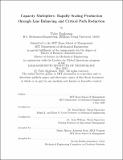Capacity Multipliers: Rapidly Scaling Production through Line Balancing and Critical Path Reduction
Author(s)
Eggleston, Tyler
DownloadThesis PDF (2.224Mb)
Advisor
Hardt, David
Willems, Sean
Terms of use
Metadata
Show full item recordAbstract
Sustained and rapid growth in manufacturing companies frequently generates challenges in scaling production to meet demand. As demand approaches and exceeds production capacity, the backlog of orders will increase and drive up lead times. Long lead times are unattractive to customers and threaten to inhibit continued growth. Companies in this situation need to rapidly scale production to maintain rapid growth.
The researcher hypothesized that shortening the duration of the critical path and balancing resource utilization could rapidly increase the throughput of a capacity constrained factory. The investigation uses ShopSabre CNC as a case study to investigate techniques including the base-stock inventory system, the kanban inventory system, workflow analysis diagrams, push-pull barrier definition, and division and coordination of labor to reduce the critical path and balance utilization. The effectiveness
of the techniques are measured by the observed or calculated increase in throughput capacity.
The result of the research finds that all techniques that effectively shorten the critical path or balance utilization, particularly by alleviating the production bottleneck, result in increased aggregate throughput capacity. The investigation culminates with a simulation of the final assembly, calibration, and test sequence. It demonstrates that increasing the footprint of the factory by two times and applying the techniques included in the investigation results in a five-fold capacity increase.
Date issued
2022-05Department
Massachusetts Institute of Technology. Department of Mechanical Engineering; Sloan School of ManagementPublisher
Massachusetts Institute of Technology